Guinea pig grooming is essential for a healthy pet and a happy household. Your little furball requires regular coat brushing, nail trimming, and other essentials, like cleaning ears, trimming hair, and checking the state of their teeth.
How to bathe your guinea pig?
Guinea pigs bathe themselves. Like cats, they perform regular cleaning by licking and smoothing their fur. But should your pet find itself in a situation that requires more than that: here is a step-by-step guide on how to bathe a guinea pig.
For those times when a bath is needed, it’s important to know the right way to bring on the suds without causing your fuzzy buddy anxiety. To learn about the ins and outs of proper guinea pig grooming, check out the information below.
Best Way to Bathe a Guinea Pig
While guinea pigs, or “cavies” as they are often called, take care of their own bathing needs on a regular basis, there will be times outside of the regular routine that may require you to help. For instance, if your pet gets particularly dirty, sticky or stinky – or when a medical issue prompts your vet to instruct you on guinea pig bathing.
The Right Time: To Bathe or Not to Bathe
Sometimes a bath is unavoidable. If the situation at hand requires more than your pet’s natural grooming habits and isn’t manageable with a baby wipe or damp washcloth, it’s time to step in. Sometimes, your little guy may just need a quick dip to clear up some dirty fur. Other times, the reason for a bath may be something more serious.
Here are some situations that make it imperative to bathe your guinea pig:
- Parasites like lice, fleas or mites
- Fungal infection, like ringworm
- Soiled fur from diarrhea or vomiting
- Your guinea pig gets into a substance that is dangerous/toxic for it. Always consult your vet if this happens.
In each of these instances, you will likely need the advice of a veterinarian. There are still other times when a bath just isn’t a good idea, unless you check with your vet first.
Call the veterinarian before bathing if your guinea pig is:
- Sick. Respiratory infections, like pneumonia, are common in guinea pigs. Don’t bathe if your pet is under the weather.
- Very young. They are vulnerable to illness.
- Expecting (or might be). If a bath is unavoidable, handle with care.
The Right Bath Time Supplies: What You Need
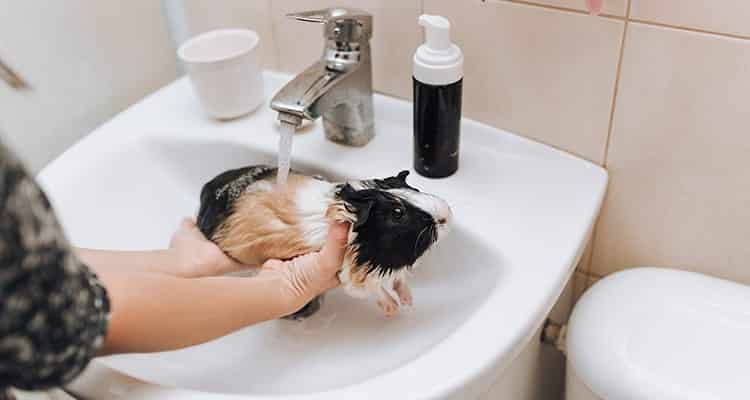
As you can imagine, you just can’t pull out whatever shampoo is in the shower and use it on your pet. A guinea pig is too small and delicate for some of the harsh ingredients in people shampoo. Similarly, you don’t want to use just any comb or brush around the house. For your pet’s sake and your own, make sure you have the right tools for bath time:
- Gentle shampoo. The pet shop will have one for small and baby animals.
- Narrow-toothed comb
- Soft-bristled brush
- Sink or plastic tub with an inch or two of water
- Two washcloths
- Three hand towels
- Hair dryer with a cool setting
The Bathing of a Guinea Pig: A Step-by-Step Guide
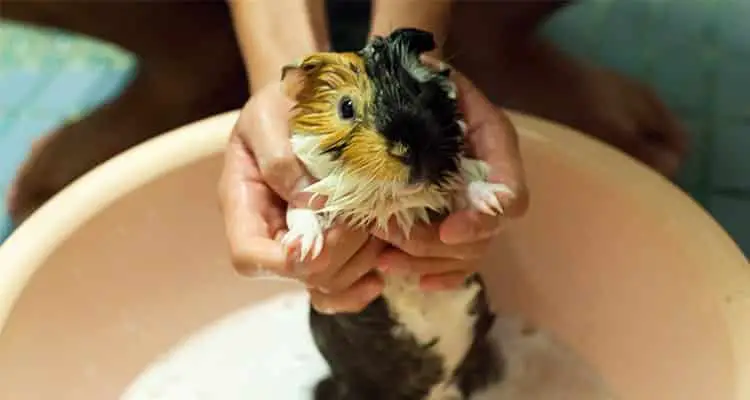
1. Clean Your Guinea Pig’s Habitat
Yes, this is a step-by-step for bathing, but the bath is useless if the cage isn’t clean and properly prepared to receive your freshly bathed pet!
- Move our guinea pig to a safe, enclosed space outside of its cage.
- Remove everything from the cage.
- Wash the food bowl, water bottle, and anything else in warm, soapy water. Dry well.
- Empty all bedding material from the floor of the cage.
- Clean the cage floor with a hot water and mild detergent. Rinse and dry well.
- Make sure everything is dry before putting down new bedding and restocking the cage.
2. Give Your Guinea Pig a Brushing
If you haven’t brushed it lately, give your guinea pig’s fur a run-through with the brush or narrow-toothed comb. This is mainly just to remove any loose hair. You don’t want to shampoo any more fur than you have to!
While you are brushing, check your pet’s skin for any signs of an issue: mites, lice, crustiness, lice, patches of missing fur. If you unexpectedly find any of that, stop and call the veterinarian.
3. Set the mood.
Bath time can make any animal anxious. Fortunately, you probably already know how to soothe your furry friend. In whatever way you know it likes, make your guinea pig feel safe and comfortable, so it can feel calm in the bath. Some ideas for calming your guinea pig include:
- Holding it close
- Soothe it with your voice
- Pet it in a way you know it likes
- Have its favorite treat handy for distraction and bribery
- Do you normally play music in the house? Bring those sounds into the bathing area.
- If you can bring the bathing area into a part of the house your pet if fond of, even better.
A tip before the next step: If you are using a plastic tub, avoid keeping it up high on a countertop. Instead, bring the tub down to the ground, for safety’s sake. Just in case your pet gets spooked, at least it won’t get hurt on its jump from your hands. Also, never walk away from your guinea pig when it is in the water.
4. Do a gentle prewash.
Remove any crustiness or sticky spots with a warm, damp towel. Take a soft, clean washcloth and run it under lukewarm water. You don’t want the towel to be very wet, so make sure to wring it out before using it on your guinea pig. Very gently stroke the soiled or matted patches with the damp towel to loosen the hair around any chunky or greasy areas.
5. Prepare the bath.
You will want a plastic tub or bowl that is deep enough to for your guinea pig to stand, but don’t fill it with water. Take that washcloth you used for the prewash and fold it up at the bottom of the bowl to create a little padding and traction for your guinea pig. Now add just about 2 inches of lukewarm water.
Tip: Set up your bath in a warm spot. Guinea pigs can quickly catch a chill once they are wet.
6. Let your guinea pig get used to the water.
Don’t just plop your guinea pig down into the water. You know this isn’t going to be scary, but your pet doesn’t. Move slowly.
Gently lower your guinea pig into the bowl, feet first. If your pet is scraping and scrambling, give it a minute to see if that calms down. If it doesn’t, you can remove your guinea pig and soothe it. Then try again.
Once you get your guinea pig calmed down, give it time to acclimate to its watery surroundings. This may be a good time to offer a treat, as a reward for being calm and to say, “see how fun bath time is?”
7. Wash your pet’s face.
If your guinea pig’s face needs a washing, don’t pour water on it. Take a soft washcloth, dampen it in the water and very gently stroke your pet’s face with the soft cloth. That should loosen anything there and clean up the facial fur nicely.
8. Start with a gentle rinse of water on his back.
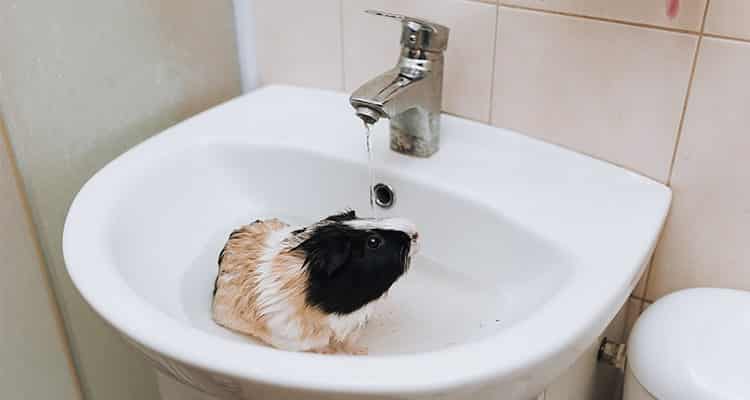
Don’t throw off the calm vibe by dumping water on your guinea pig. Keep it slow and steady. Using your hands, scoop just a little of the water and gently pour it over the guinea pig’s back. Avoiding its eyes and ears, continue to use little handfuls of water to get his fur wet. Do the best you can to shield your pet’s face from the water.
9. Shampoo.
Put a few drops of the gentle shampoo between your fingers. Rub your fingers together to get some suds and then gently rub the shampoo into the guinea pig’s fur. If your guinea pig likes its back rubbed a certain way, use those strokes here to convey the message of “this is safe” and to encourage your pet to stay calm.
Avoid the face and ears when you are shampooing. Even the gentle pet shampoo can be irritating to your pet’s sensitive eyes.
10. Repeat step 8.
Give your guinea pig a warm rinse, starting with little palmfuls of water on its back. Gently repeat until all the shampoo suds are rinsed away. Just as with humans, leaving a trace of shampoo can be irritating to the skin.
Tip before moving on to the next step: Have three warm, dry hand towels at-the-ready. Place one on a flat surface right next to the bath.
11. Remove your guinea pig from the water and place on one of the hand towels.
Set the guinea pig on a towel and hold him gently as you warp the other dry towel around him. Softly smooth and pat the towel to absorb the excess moisture from your pet’s fur.
12. Towel dry your pet’s fur.
Take the third towel to replace the towel you are using. Don’t be aggressive with the towel. You don’t have to scrub the fur dry. Just blot the guinea pig’s body fur softly with the towel until your shivering little bundle feels dry and warm. Use caution around your pet’s face.
13. Brush the fur again.
Now that your guinea pig is clean and fluffy, use the soft-bristled brush to smooth out the freshly dried fur and remove any remaining tangles. It’s also a good time to cuddle and make sure your pet feels safe and soothed.
14. If needed: carefully use the hairdryer.
If it’s cold in the house and you want to make sure your guinea pig is warm and dry, you can use the hairdryer. But you must take some precautions:
- Put the dryer on a low, cool setting
- To prevent burning, keep your hand in front of the air so you can always monitor the temperature.
- Keep the dryer moving so the heat never concentrates in one spot
- Avoid the guinea pig’s ears and face
- Stop right away if the noise or blowing air makes your pet anxious
15. Keep your pet warm after the bath.
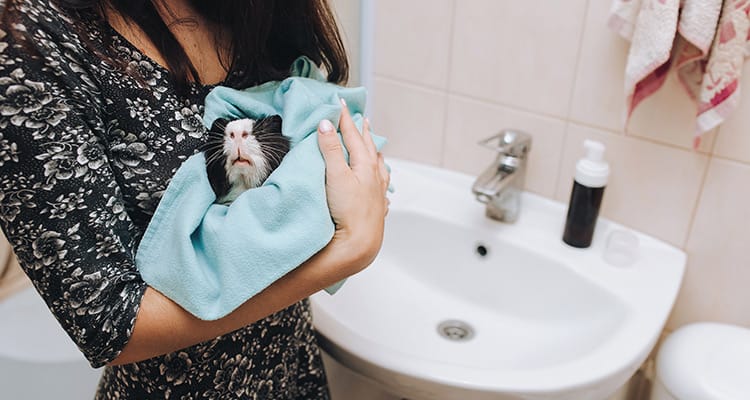
Especially if your guinea pig is shivering, take steps to ensure it stays warm and dry to recover its body temperature after the bath. If the fur feels dry to the touch, maybe your pet needs a little more snuggling in a warm towel, tucked in against your chest.
16. Post-bath play.
Once your pet has recovered after the bath and feels warm again, it may just pass out in its cage (which is clean and ready, right?) But if your guinea pig is still awake, it’s a nice touch to do something it really enjoys after the bath, to reinforce the positive association with bath time. A treat, a backscratching, a cuddle – whatever your pet prefers.
Guinea Pig Grooming Routine From Head-to-Rump
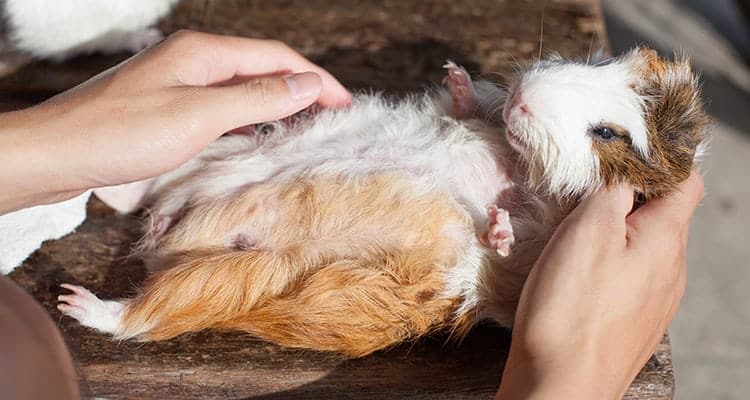
Baths may be an occasional grooming occurrence, but there are several things that should be part of a very regular grooming routine to keep your guinea pig’s hygiene up to snuff.
Eyes and nose
Examine your guinea pig’s eyes and nose for unusual discharge.
Ears
Perform weekly checks of your pet’s ear health. Look for any indication of ear mites, infection or wax buildup.
Signs your guinea pig’s ears need attention:
| Scratching or rubbing of ears | Ear mites | See the vet |
| Head shaking | Ear mites | See the vet |
| Foul smell | Bacterial infection | See the vet |
| Dark crusty substance | Bacterial infection | See the vet |
| Waxy buildup | Time for an ear cleaning | You can do this. |
Cleaning Your Guinea Pig’s Ears
When you see a waxy buildup in your pet’s ears, it’s time for a cleaning. If you exercise caution, this is something you can do at home. It should be done every month. If you notice an extreme buildup, or something just doesn’t seem quite right, don’t take any chances. Schedule an ear cleaning at the vet’s office.
Supplies:
How to:
Dip the cotton swab in oil and clean the outer area of each ear. Just remove any visible dirt and wax. Don’t dig in deep or attempt to remove large amount of wax. The cleanings you do at home should be regular, quick and superficial. Any serious cleaning should be performed by a professional.
- Keep your cleaning superficial to avoid damage to the inner ear.
- Be sure to clean the base of the ear.
- Repeat these steps if necessary.
Cleaning Your Guinea Pig’s Teeth
You can’t fix teeth at home, of course. But you can regularly monitor the health of your pet’s teeth to ensure any problems get acted on quickly. When dealing with guinea pig teeth, “regular” checks means every week. Why?
Guinea pigs’ teeth grow throughout life. And they grow quickly, and they can grow long. Check their mouth weekly to find out if any teeth are overgrown, impacted, loose or broken. Overgrown or broken teeth will need to be trimmed or filed down by a professional. Impacted teeth will require dental work.
Because of their ever-growing teeth, guinea pigs need plenty of things to chew on, starting with good quality hay as part of their diet. In addition, it’s important to give them other things to gnaw on to keep those teeth worn down. Cardboard and wood are good favorites.
What to look for in healthy teeth:
- Top and bottom incisors should match up in length. Up to 1.5 cm is good.
- No signs of deterioration
- No bumps felt along the jawline (a sign of overgrown roots)
- No sores or injuries in the mouth (a sign of overgrown teeth)
- Your guinea pig has no signs of an issue with chewing or eating food normally
-
If you notice anything that looks amiss in your guinea pig’s mouth, or if your pet seems to have trouble chewing its food, consult with your veterinarian.
Cleaning The Coat and Skin
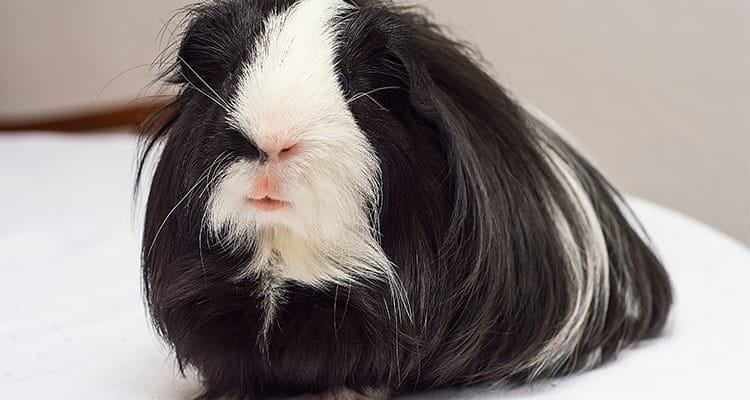
Part of what makes a guinea pig such a snuggly pet is its soft, flat fur. Taking care of it as part of a regular routine can help you identify and reduce the severity of problems associated with skin and fur.
Brushing – How Often?
How long your guinea pig’s hair grows will determine how often you have to brush. The longer the hair, the more easily matted and tangled it gets. Generally, weekly is enough for a short-haired pet, but long-hair will require grooming as-needed, on a daily basis. When your guinea pig is shedding, it may need more frequent brushing.
You’ll need a small, soft-bristled brush and a narrow-toothed comb, this twin brush that has both is a great choice. Have scissors on-hand, too. If there is a stubbornly clumped mat of hair, you may as well snip it out. We all know how much it can hurt to tug out knotted hair with a comb or brush. Save your pet the pain and just use scissors.
Brushing How-to
Groom in the direction the hair lays. Stroke with the brush from head-to-rump, from back to belly. If your pet is shedding, you may want to make sure you have a garbage can nearby to toss the loose locks. Or, you may wet your hand or a paper towel, to give the shed hair something to stick to.
Long-haired guinea pigs and other types have coats with characteristics unique to their variety. Different hair types require different tools and more frequent brushing. If your pet has lots of long, thick hair, you’ll need a stronger comb or brush to make it through that dense coat.
Trimming Hair
You may have to give your pet a haircut now and then. It’s easy if you have good grooming scissors, a comb and some treats on-hand.
Feet and nails
As far as feet go, you are just inspecting for anything that looks painful, such as sores or inflamed areas. If you find any, call your veterinarian. Check nail-length, too. If nails are too long or appear damaged or broken, bring your guinea pig to a professional for a nail trimming. For a detailed guide on this topic, please check out this article we wrote about Guinea Pig Nails.
Trimming Nail at Home
There are a few reasons to trim the nails of your guinea pig twice a month: it keeps the nails from becoming ingrown, and it reduces the chance of you getting scratched.
Many guinea pigs don’t like this manicure. Like bath time, you can try to acclimate your pet to this routine and feel soothed. Play with your guinea pet first, have treats handy, and move slowly.
You can use a nail clipper designed for people, or one made for small animals. Have a nail file ready, just in case you end up with any sharp or jagged nail edges.
Be careful! You can cut your guinea pigs “quick” if you’re not aware of where – or what – it is. The quick is the place on a toenail where the nerves and blood vessels are. If you cut the quick by mistake, there will be bleeding. Any blood flow that you can’t stop after two to three minutes of pressure should be handled at the hospital.
Cleaning The Rear End
Check the fur and skin around the guinea pig’s rear often. Fur that is stuck together with feces or urine should be cleaned with a damp cloth or gentle baby wipe. Ignoring it can get stinky and attract flies. If you notice any wounds or maggots on your guinea pig’s rear, it is cause for immediate concern. These are signs of flystrike.
Flystrike
Flystrike is a potentially fatal condition that happens when flies lay their eggs around the anus. If left unchecked, the eggs hatch into maggots, which attack the flesh around the anus. Call your vet right away, because this infestation requires removal of the parasites, as well as medication to prevent infection.
To prevent flystrike, keep your pet’s rear clean and dry.
Cleaning the Grease Gland
At the end of its tailbone, your guinea pig has a very small gland that secretes an oil for scenting and marking. The secretions can be oily, greasy, or waxy. If the secretions build up and back up, the area around the grease gland can become irritated or infected. Regular maintenance of the gland is an easier job than attending to it once it’s all backed up.
Right about where our pet’s tail would be, you will notice a spot that is a little sticky. Check around the area for any redness, dry skin, or soreness. You’ll know if the grease gland is dirty if the fur is bunched up around something that looks like earwax.
To clean the gland, break down the wax with something safe and gentle: coconut oil or olive oil works great. Let the oil sit a bit, then wipe it off with a warm, wet washcloth. You may have to repeat the process. Or you may have to go for an all-out bath of the rear end.
Grease Gland Issues
If the area around the gland is raw, bleeding or feels unusually warm to the touch, the gland may be infected. You’ll need to go to the vet for a professional assessment. If it’s the grease gland, your guinea pig will need a professional cleaning and maybe even an antibiotic. If it’s not the grease gland, those symptoms are still concerning, so the vet can find out what else is causing them.
Tips for Bathing Your Guinea Pig for the First Time
Your guinea pig and you are both feeling a sense of apprehension and confusion at the right way to go about this next step in your bonding experience. Bathing connects you both and fulfills an important duty to remove odors and freshen up your cavies.
A little goes a long way because guinea pigs don’t like getting wet.
- Be gentle, lift them slowly and allow them to get adjusted to the slow flow of water.
- The water can be filled in a cup or you can cup your hands.
- Then, take the cupped water and gently pour it in small amounts over the back of your guinea pig.
- Alternatively, you can try spot cleaning with a rag instead of applying the water directly on them.
- Do not wash their face. This will agitate them.
- Finally, wrap your guinea pig in a protective way with a warm towel to signal the end of this activity.
You can try using a blow dryer but my guinea pigs hates it. This is why I have to make sure the towel is thick, absorbent and gets the drying job done in the best possible way. A few minutes under the sun helps as well.
How Often Should You Bathe a Guinea Pig?
How dirty is your guinea pig getting? Some guinea pigs clean up nicely without the need to frequently bathe or perform spot cleaning. Others like to get dirty as they tussle around their enclosure or during outdoor playtime.
It depends entirely on each guinea pig for how often you need to bathe them. A general and minimal amount of bathing rests at about 2-4 times a year. That’s right. This is not a weekly ritual at all.
If your guinea pig is hairless, this occurs even less because of their sensitive skin. Try spot cleaning with a rag that is slightly wet or damp instead of a full bath.
A guinea pig with skin infections or a history with battling parasites might need an anti-parasite bath as recommended by the vet. You may bathe your guinea pigs as often as once a month in the summer and every two months in the fall, winter and spring.
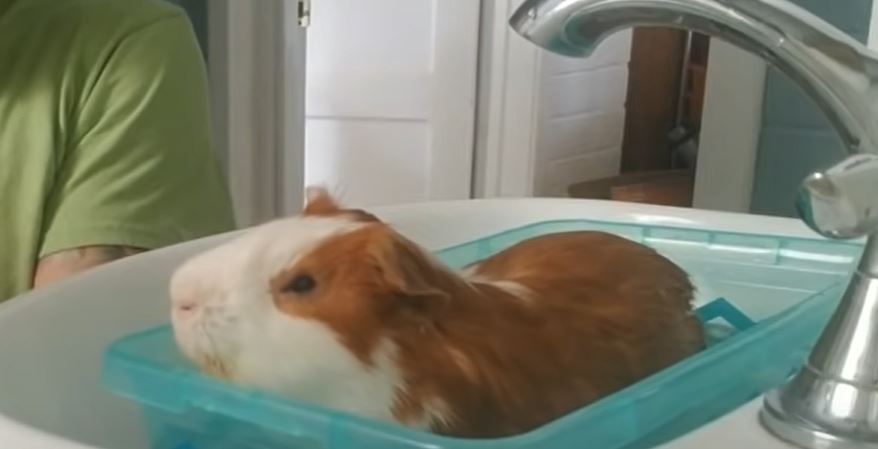
Can You Bathe a Guinea Pig With Baby Shampoo?
Baby shampoo is made with safer chemicals for the sensitive skin of young children. We recommend that animals use their appropriate shampoos made for them instead. Using baby shampoo should be done so for guinea pigs only out of desperation and in very small amounts.
There are many types of small animal shampoos available at our local pet shop and at the local vet we frequently visit for our pocket pets. You can also search for them online. Make sure that you opt for unscented varieties of shampoos for babies or small animals.
Recommending any other type of shampoo except for ones marketed and sold for guinea pigs and other small animals comes with added risks.
You do not want to deal with skin infections on your guinea pig and they will suffer for it as well. It’s best to play it safe and avoid baby shampoo if you can.
Selecting a Guinea Pig Safe Shampoo
Do you enjoy shopping when there are multiple options available for the item you are looking for? In the case of buying guinea pig shampoo, do you want to choose from all the options online, in the pet shop or would you like us to direct you to the ones we use?
In this case, we would prefer to help you look for certain qualities present in the best and safest types of pocket pet shampoos. Look for the following:
- All natural
- Safe
- Gentle
- Biodegradable
- Sustainably made
- Tearless
- Doesn’t dry out skin
- No actual soap
- Edible
- Non-toxic
- No fragrance
- Naturally hydrating
- Soothes skin irritation
- Inexpensive
There is no need to buy the most expensive options. There are cheap solutions and brands, but you should look for most of the items in the list above to give you a sense of comfort that you have chosen a safe shampoo for your guinea pig.
Do Guinea Pigs Like to Take Baths?
It’s hard to find any animals who enjoy taking baths compared to the many who don’t. Guinea pigs are included in the large groups of pets that may or may not resist fiercely to the idea of bathing.
It’s simply not a natural act and one they are not adapted to. The experience itself has to be less daunting.
You can try to make it pleasurable by making it an activity centered around treats, positive vocal tones, physical and gentle praise with rewards at the end such as playtime or more treats.
Guinea pigs like to groom themselves as they are considered generally clean animals who don’t require frequent bathing or none at all in some cases.
In short, our best answer based on experience is that guinea pigs do not like being bathed unless you build a larger picture around the activity that is more about bonding, treats or loving rewards to get through the experience in the most positive way.
Can You Bathe a Guinea Pig With Dog Shampoo?
We do not recommend using dog shampoo on guinea pigs. There are more shampoo options made for smaller animals that take into account the increased sensitivity of their skin compared to dogs.
Our dog shampoo bottle lasts a long time in the house and it’s tempting to use it for our cavies, but we have resisted. The best case scenario is using shampoo made for small animals.
When you’re in a jam, try spot cleaning with only a drop of dish soap. Make the rag slightly dampened and do not try to penetrate deep into the skin. You are only trying to clean off some dirt patches on their fur.
Use a rag with only water drops instead if you can. Remember that guinea pigs do not need to bathe often as they can groom themselves which dogs are not as good at doing.
How to Bathe a Guinea Pig Without Shampoo
Guinea pigs groom themselves and usually resist to the unnatural act of trying to be forcefully bathed, You can resist the urgency of a bath and resort to other solutions such as:
- Water dampened rag
- No-rinse dry shampoo
- Pet-friendly wipes
- Warm water and sponge
Spot cleaning is the best way to deal with any noticeable stains on the coat of your cavies. You do not need to scrub them thoroughly or get deep into the skin pores to clean animals who are used to cleaning themselves.
If you notice or smell something off, a gentle spot cleaning may do the trick. Start small and see if this bit of wiping completed the job. If your guinea pig has a persistent smell or stain that is tough to remove, you can resort to pet-friendly shampoo derived for small animals.
Common Illnesses that Affect Guinea Pigs
Parasites
Several different species of mites can affect guinea pigs. The two most common are Chirodiscoides caviae and Trixacarus caviae (sarcoptic mange) mites.
Sarcoptic mange mites usually cause extreme itchiness. Your guinea pig will scratch so much that lesions may form.
Signs of sarcoptic mites include:
- Skin changes: thick, yellowish, crusty
- Wounds from scratching
- Hair loss around the area of infestation
- Unexplained weight loss, extreme lethargy
Fleas, lice, and ear mites can also affect guinea pigs. Whenever you notice symptoms, check in with your vet. Treatments are usually simple, effective, and necessary for your pet’s health.
Fungal infections
Ringworm is the most common fungal infection that affects guinea pigs. Symptoms include circular, hairless spots that are tender to the touch. It often starts on the face, but quickly spreads to the body.
Keep in mind that ringworm is highly contagious – and humans can catch it from pets. Wear gloves when you inspect your guinea pig. The vet will diagnose with a lab test. If confirmed to be ringworm, this condition will require a vet visit and the treatment may include medicated shampoos, antifungal medication, and an antibiotic, if sores are in danger of becoming infected.
To prevent ringworm, keep your pet’s habitat as clean and dry as possible. Ringworm thrives in damp conditions.
Barbering
As its name implies, barbering is the removal of hair – by other guinea pigs or self-inflicted. It is an emotionally based behavior and causes can include boredom or issues between two guinea pigs in the same habitat.
Treatment involves providing the guinea pig with more stimulation, redirecting chewing to hay or chew toys, and separating guinea pigs if they are barbering each other.
Slobbers
Slobbers is a type of moist dermatitis that can form under the chin and neck due to excessive salivation. It is usually due to tooth and mouth problems, like malocclusion. Slobbers requires a vet visit for a thorough dental exam.
Bumblefoot (Pododermatitis)
Pododermatitis means skin infection of the foot. Symptoms include swelling, ulceration, and thickening of the skin. If left untreated, it can lead to a bone infection.
Causes may include a rough or dirty cage or inappropriate cage bedding. If your guinea pig is obese, the lack of mobility can contribute to bumblefoot.
Treatments may include foot bandages, antibiotics, analgesics or surgery.
Scurvy
Scurvy is a vitamin C deficiency due to a lack of leafy greens in the diet. It is important to make sure your pet is getting enough vitamin C. If your pet displays any of these symptoms, have it checked for scurvy:
- Rough coat
- Unsteady hind legs
- Diarrhea
- Joint swelling
- Hair loss
Ideas for a healthy diet that prevents scurvy include:
About one cup daily of:
- Romaine lettuce
- Spinach
- Kale
- Parsley
Once or twice a week:
- Carrots
- Zucchini
- Sweet potato
Guinea Pigs as a Pets
When cared for and fed properly, guinea pigs are generally very healthy animals and relatively easy to care for as pets. They have simple needs that include a healthy diet, a clean cage with room to run and exercise, and daily attention from you. Bathing is just a “sometimes” thing to incorporate into your regular routine of showing love and attention to your pet. When you give them all they need, guinea pigs make a wonderful addition to a loving family.


